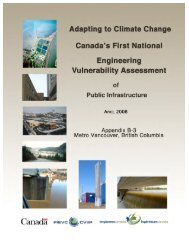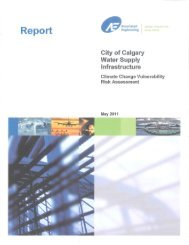Final Report - Vulnerability Committee
Final Report - Vulnerability Committee
Final Report - Vulnerability Committee
You also want an ePaper? Increase the reach of your titles
YUMPU automatically turns print PDFs into web optimized ePapers that Google loves.
Flood Control Dam Water Resources Infrastructure Assessment -<strong>Final</strong> <strong>Report</strong>Climate Analysis and Projections3.2.2.4 Climate ProjectionsFindingsCurrent climate projections indicate that temperatures for most of North America will increase and likelyexceed the global mean warming (Christensen et al., 2007, IPCC). This projected increase in temperatureis expected to be between 2°C to 3°C and is based on annual means (Christensen et al., 2007, IPCC). Inaddition, the fourth IPCC assessment report concluded that there will be a reduced risk of extreme lowtemperatures (Meehl et al., 2007, IPCC). Cheng et al. (2009b) used a statistical downscaled approach onfive general circulation models (GCM) outputs to derive future climate information and found that it is verylikely that cold related mortality will decrease by about 60% in Toronto by the 2050s, implying a warmingof extreme low temperature. A study by Kharin et al. (2007) indicates that cold extremes warm faster thanwarm extremes by about 30% - 40%, globally averaged.IPCC recognized climate model outputs available on the CCCSN, project an annual mean minimum airtemperature increase of approximately 2.7°C for the grid cell encompassing the Toronto area (methodspresented in Section 3.1.4.2). It is noted that this annual value will not necessarily influence changes inthe number of days with temperatures below -30°C.Probability ScoringThe probability score for the future was adjusted from the historical value of “3” to a revised probabilityscore of “2” based on the above-noted climate projections and trends, which both indicate a decrease inthe number of extreme cold days and warming temperatures.3.2.3 Heat Wave3.2.3.1 DefinitionA meteorological heat wave is defined by Environment Canada (Meteorological Service of Canada (MSC)- Ontario Region, 2009b) as three or more consecutive days in which the maximum temperature isgreater than or equal to 32°C. For the purposes of this study, the number of heat wave occurrences withina given year was considered. As described in Section 3.1.3 of this chapter, this parameter is a tier twodefinition.3.2.3.2 Historical ClimateFindingsDaily temperature data for Toronto Pearson International Airport, obtained from Environment Canada’sClimate Data Online (Environment Canada, 2008), was analyzed for the occurrences of heat waves from1971 to 2000 based on the above definition. It was determined that 17 heat waves occurred during this30-year period. This translates to an average of 0.57 heat waves per year (17/30). The majority of heatwaves lasted for the defining three days; however, there was one heat wave that lasted for 6 days, threeheat waves that lasted for 5 days, and two heat waves that lasted for 4 days.Probability ScoringBased on the findings above, 0.57 (heat waves per year) was compared to the established ranges inTable 3-1 and was subsequently ascribed a probability score of “4”, with a “moderate/possible” chance ofoccurrence.3.2.3.3 TrendsNo studies specifically analysing trends of heat waves were identified, although various warming trendswere established in the articles reviewed, as discussed in section 3.2.1.3 of this chapter.GENIVAR 3-9








